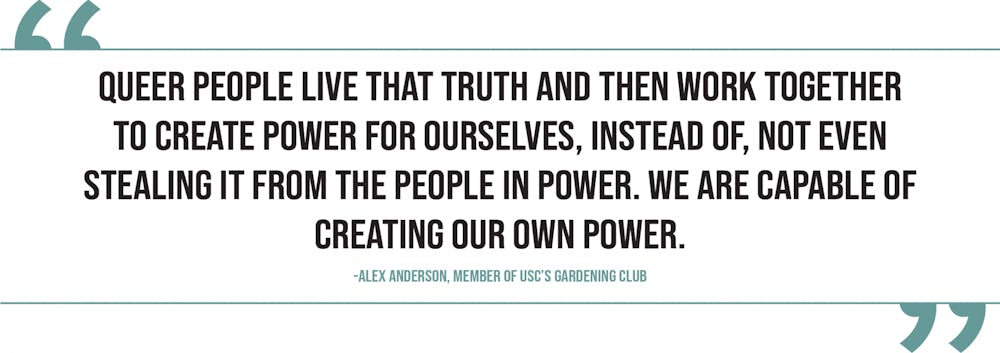Sexuality and the environment may seem unrelated at first, but Alex Anderson, a member of USC’s gardening club, relates both to cultural inequalities.
"(Environmentalism and LGBTQIA+ issues) tend to naturally go together,” Anderson, a second-year arts education student, said. "The society that we live in both doesn’t value our environment and doesn’t value LGBTQ+ people.”
Access to food can contribute to this inequality. Much of the Midlands are considered to be food deserts, or areas without ready access to fresh foods or grocery stores, according to the South Carolina Department of Health and Environmental Control (SCDHEC).
Anderson said gardening could be a tool to combat a lack of produce in stores.
“Seeds at Walmart are not that expensive, you know,” Anderson said. “If oppressed people control their access to food, that’s just one more thing that props us up.”
Similarly to growing healthy food when none is made available, coming into one's own sexual or gender identity is an “act of rebellion,” Anderson said.
“Queer people live that truth and then work together to create power for ourselves, instead of, not even stealing it from the people in power,” Anderson said. “We are capable of creating our own power.”

What that power looks like, though, can be tricky to define. Queer environmental issues exist against the backdrop of intersectional environmentalism as a whole, an area of interest for USC philosophy department chair Matt Kisner.
Intersectional movements, he said, focus on a wide range of people, including those of different races, sexualities and socioeconomic statuses. For example, establishing a garden, although perhaps empowering, requires more than seeds — it requires space, time and physical ability.
“You see how there are certain kinds of common structures or patterns that overlap between issues,” Kisner said. “Intersectionality is about studying those similarities and structural connections.”
One example of an environmentally intersectional issue is a communities’ location relative to toxic waste.
Nationwide, communities near toxic waste dumping and storage facilities are comprised of roughly 45% people of color. However, people of color make up less than 30% of communities that are distanced from such waste facilities.
This issue is intersectional, Kisner said. It affects many types of people — Black, Latino and immigrant communities. Understanding and solving these disparities requires bringing these stakeholders to the table, Kisner said.
“You need to have the people who are affected by these harms, and they need to be represented, they need to be part of the people who are speaking out about the experiences that they're having,” Kisner said.
It can be difficult to involve individuals from oppressed communities in these discussions, though. Those who are economically unable to move out of a flood zone, for example, have more immediate concerns than legislation, Kisner said.
“It’s hard in any community to get people involved in that kind of civic participation, but it's particularly demanding on people who are working multiple jobs and are struggling with childcare issues,” Kisner said.
It’s also more difficult to address LGBTQIA+ concerns via community involvement because of geographic distribution. Because so many marginalized communities are centered around toxic waste disposal sites, they’re affected “disproportionately,” Kisner said. “But the LGBTQ population isn’t … centralized in quite the same way.”
Anderson said that these hazards are similar in effect to hazards faced by the LGBTQIA+ community.
“When people are destroying the planet for profit … it takes away people’s opportunity, and so I feel like because of how impacted LGBTQ people are by our prejudiced society, that is definitely a way that LGBTQ and environmentalism overlap,” Anderson said.
Jory Fleming, an adjunct faculty member in the geography department, explored these overlaps in a class through a collection of poems by Brian Teare called “Doomstead Days.”
“(Teare) went out and walked basically in different locations … He combined his own experience directly in nature with his experiences from both as a gay man, and he also interacts with chronic illnesses,” Fleming said.
Fleming said he uses this poetry to showcase the power of people’s unique perspectives on the environment. He considers these perspectives a type of data, alongside traditional scientific data like United Nations’ climate change report. He talks about individual power in a similar way to Anderson.
“There's just as much power in somebody saying ‘oh, my garden which I've cared for all my life is changing ... These are just as valid of ways of understanding and acknowledging climate change as an IPCC report that uses a climate model,” Fleming said.

